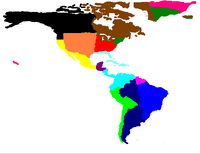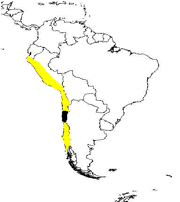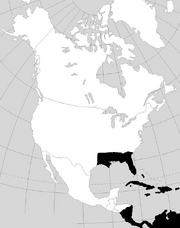
Map of the Brendanias at 1753

Map of North Brendania, 2010.

Map of the colonies in the OTL United States. Orange are Spanish, Green are Celtic, Brown are Norse, Light Blue is Welsh, Red in British, Purple is Dutch, Yellow is Chinese, and Dark Blue is Russian.
The colonization of the Brendanias is held to be at 574, when Saint Brendan reached North Brendania. The Celtics established many colonies in Iceland, Greenland, and North Brendania. The Phoenicians were actually the first to reach the Brendanias, arriving in 1000 BC. However, the Celtic discovery led to the colonization of the Brendanias. The Celtics were followed by the Polynesians, Norse, Welsh, Normans, Mali, Chinese, and many more. Four Colonial Wars and two World Wars shaped the borders of nations and colonies on the Brendanias, making it change much during the 1436 years since the Celtics first landed.
1000 BC: Phoenicia[]
In the Middle East the Phoenicia Civilization was at its highpoint. It was one of the main powers in the Mediterranean Sea and part of its culture was maritime trading. By 1000 BC the Phoencians were curious about what lay beyond the western side of the Mediterranean. So in 1000 BC a fleet of ships were sent out to discover what was beyond the Mediterranean. The fleet managed to land in OTL Brazil, which centuries later would be known as part of South Brendania. The Native Americans at Brazil taught the Phoencians many things about the land and the Phoencians became excited. When some of the fleet returned to Phoenicia in 1003 the leader of the civilization sent out people to colonized this new land. The Phoencians became rich in power but kept all knowledge of the lands to itself as they did not want other people heading there. The lands remained part of Phoenicia for about 500 years but when the civilization declined a messenger came to the colony saying there were free of Phoenicia control. The people there managed to survive without Phoenician help.
574 AD: Ireland[]

Map of Irish colonies, 1100.
In 574 a monk by the name of Saint Brendan went on a voyage across the Atlantic Ocean searching for Paradise. He went across Iceland and Greenland before landing in OTL Connecticut. He set up a settlement there by the name of New Clonfert. New Clonfert traded with the local Native Populations. After 3 years he returned to Ireland with things from North America such as a Native American. This stirred the interest of the Celtic Tribes and in 581 colonizers from Ireland went to the settlement of New Clonfert. The settlement soon expanded and by 587 New Clonfert had expanded to OTL Rhode Island and Massachusetts. The Celtic Tribes became very wealthy and united into the Celtic Union, covering all of the Ireland island. The Celtic Union was now one of the most successful nations in Europe. New Clonfert traded with all of the tribes of New England. New Clonfert would later expand to the Ohio River Valley, where a dispute with Britain would lead to the Third Colonial War. The Celtic Union would lose the Third Colonial War and lose out on the Ohio River valley.
750 AD: Polynesia[]

Map of Polynesian colonies.
Polynesia from 300 AD to 1200 AD explored and colonized much of the Pacific. Their lands stretched from New Zealand to Hawaii. The Polynesians used canoes to travel to the islands of the Pacific and soon South America. They first settled in OTL Isla Sala y Gomez. The Polynesians soon traded with the Natives in OTL Chile. During the trading the Polynesians discovered the wonders of South America and soon set up coastal towns. Riches soon came these towns, the most prominent being Fou A'ai (New City in Somoan) located in OTL Santiago. One of the most common things traded were Native sweet potatoes for Polynesian chickens. By 800 Polynesia had colonized all of OTL Chile and set expeditions into the Te'le (Big in Somoan) Mountains. In 802 Polynesian lands were officially united into the "Polynesia Empire" and had territory in most of the southern Pacific. The Polynesia Empire expanded as a result of much more land and colonized western OTL Australia. Polynesia soon had territory in OTL Peru. Polynesia Empire was now flourishing.
[]

Norse colonies in 1753.
In Scandinavia the Vikings were in control and had already colonized portions of Iceland and Greenland as the Celtic Union had colonized other parts. The Norse learned of these places from the Union. The Vikings settled America in 830 AD, and had named their territory Vinland, which was located in Newfoundland. The Vikings soon expanded into OTL Maine and traded with there Celtic neighbors to the south. The Vikings sent expeditions inland to explore the interior of Markland, which is OTL Canada. The Vikings soon found the Dorset People, who lived on the coasts of Markland. The Vikings soo n attacked the Dorsets but the Dorset would fight in guerrilla-style attacks, which stopped the Vikings from expanding farther. The Celtic Union helped the Vikings and sent soldiers to fight the Dorset. The Vikings and the Celtics defeated the Dorset and forced them to leave to OTL Alaska. With the Dorset defeated the Vikings settled further inland. The Norse also travelled the Great Lakes and started a settlement at OTL Kensington. Even though the Dorset were defeated the Norse were at war with the Native Americans they crossed at Kensington. The settlers at Kensington were eventually forced to return to Markland and Vinland. After that the Norse came back and defeated the Native Americans, allowing Kengsington to thrive. Kensington would later be threatened during World War I and World War II by the Virginians, and in World War I it was nearly destroyed. Kensington would be rebuilt but destroyed again during World War II, but was rebuilt again. The Norse colonies would become independent in 1994 as the nation of Markland, composed of Vinland, Helluland, and Markland.
1170 AD: Wales[]

Welsh colonies in 1753.
In 1170 Prince Madoc of Wales set off for the Americas. The ship headed south of the Celtic and Scandinavia colonies and he landed in OTL Florida. The settlement, known as Madoctown, was the first settlement of New Wales. In 1180 a ship headed for Madoctown blew off course and landed in OTL Cuba. The settlers there started a new settlement named Cardiff, after the city they sailed from. The people of Cardiff explored the surrounding islands, claiming them for Wales. The islands they colonized are known in OTL as the Bahamas, Hispanolia, and Jamaica. The Welsh then landed in OTL Florida and found Madoctown. The territory in the Caribean became part of New Wales. New Wales slowly expanded northward going as far as OTL Atlanta. Wales soon became a wealthy nation. Wales began exploring South Brendania, and established colonies in Central and South Brendania. New Wales soon expanded to Alabama in the city of Welshia, which is OTL Mobile. Welsh colonies would later become independent following Wales defeat in World War I.
1311 AD: Mali Empire[]
While the Celtic Union, Polynesia, Scandinavia, and Wales had discovered the Americas, nobody in Africa had even heard about the Americas. The Mali Empire managed to discover America by accident. A Mali fleet of 400 ships was swept off course by ocean currents. The fleet landed in OTL Virginia. After started a settlement there 1 ship returned to Africa. After the ship reported about the western lands Prince Abubakari II went there with 5 others ships of his own. They landed close to the settlement and the prince took control of the colony. The colony, New Mali, thrived and traded and fought other tribes. Several ships went back to Africa carrying the riches of North America. Prince Abubakari II never made it back as he was slain in battle. However, the Prince had a family and he was secceed by Abubakari. The Mali Empire now had several colonies in North America. However as the Mali colonies expanded north and the Celtic and Norse colonies expanded south (as a result of the Little Ice Age) war was looming. War would come 1300, when the First Colonial War began. This war ended Mali colonies and the Mali Empire itself.
1421 AD: China[]

Chinese colonies in 1753.
By 1421 AD China had discovered much of the world. It had been to India, Iran, and Africa. It had traded with European countries. In 1420 Zheng He and his fleet sailed east, away from China. In 1421 he landed in Mesoamerica. Once landing there, he found the ancient Mayas. The Chinese and the Mayas traded with each other. In 1422 Zheng He returned from Mesoamerica back to China. His superiors showed no interest but when they discovered the Polynesians, who have now taken over the islands near OTL Indochina, controlled the seas as they could blockade them, he sent out another fleet to Mesoamerica. The Chinese colonies expanded southward toward South America. The Chinese also set up colonies in OTL California. For 6 years the Chinese and Indians in Mesoamerica co-existed peacefully until 1427, when war with the Aztec Triple Alliance began. The Aztecs had the upper hand at first because China had to bring more weapons over but when the ships came the Chinese were defeating the Aztecs as they had matchlocks and gunpowder. The Aztecs lost the war and China was the main power in Mesoamerica, with the Mayas right behind them. The colonies would help China unify into the Republic of China.
1328 AD: Normandy[]

Map of Norman colonies.
Normandy was the first country from continental Europe to arrive in the Brendanias, landing in the eastern coast of South Brendania. They would name the land Brésil after the mythical Irish island, and the first settlement the Normans founded was New Bayeux, which was on the coast of South Brendania. Norman scouts would later discover the nation of Phoenicia, and the Phoenician War began. The Normans managed to gain some of the Phoenician land, but could not conquer all of Phoenicia. Brésil grew in size and covered much of eastern South Brendania. Rollo the Brown, named after his brown beard, led many expeditions into South Brendania. He is most famous for leading the Normans in their war against the Natives of South Brendania. The current capital of Brésil, Rollo City, is named in his honor. Gold would be discovered in 1400, leading a great many to go to Brésil. Brésil became a dominion of Normandy in 1878, and would later get independence in 1956.
1410 AD: Sicily[]
The Kingdom of Sicily, founded by the Normans and Scandinavians, was interest in South Brendania. So in 1410 the king of Sicily ordered a ship to be sent to the Amazon Rain forest in order to get wood, spices and minerals from South Brendania back to Sicily in order to get the kingdom more wealth. The first Sicilian ship arrived in 1410, north of Phonenicia. A small settlement was created on the coast and the explorers lived there in between expeditions. The Amazon River was explored and contact with the Polynesians was made. The Sicilians tried to get the Polynesians to become slaves for them but the Polynesians struck back at the Sicilian settlement. After this fight the ship returned to Sicily and plans for colonization of South Brendania was cancelled.
1608 AD: Tuscany[]
198 years after Sicily another Italian nations would try to colonize South Brendania, Tuscany. Fernando I of Tuscany was interested in an overseas colony and wanted to use the wealth to stop Sicily from taken over their land. Expeditions were led by Robert Thornton.
1510 AD: Spain[]
Spain's first contact with the Brendanias was in 1492 with Christopher Columbus sailing there. Here would land in OTL Cuba, and discovered the Welsh had already settled there. More exploration by Columbus would reveal that much of the new land was already colonized. Spain wanted to get some land on the new continent, so the Second Colonial War began as Spain, France, and the Netherlands. Though France and the Netherlands failed to get land, Spain managed to get control of a piece of land on the Gulf of Mexico, and named the new land Philipia. Exploration of the entire Philipia region would take 120 years, from the first exploration of the new land to the first Spaniards reaching the Great Lakes. Disputes with the border between Scandinavian colonies and Spanish colonies would lead to the Fourth Colonial War, the last of the Colonial Wars. Spanish colonies would try to get independence under Simon Bolivar, but failed. During World War II Spain entered on the side of the Axis and invaded Virginia. The Virginians later pushed the Spanish out of Virginia and soon occupied all of Philipia. Virginia would occupy southern Philipia, where a major rebellion against Virginian occupation, Castro's Rebellion, occured from 1956-1964.
1507 AD: France[]
France's first settlement was in South America in OTL Patagonia. The French worked their way up South Brendania and established more settlements. French fur traders established trading outposts in South Brendania in what became New France.
1585 AD: England[]
England began its first colony in North Brendania at a place present-day known as Roanoke, Virginia. The English there discovered remains of the past Mali settlement, which was a shock to the English. The English did not believe the natives of Africa could start colonies in this new continent so later colonization attempts in Africa would have a greater military presence. The colony managed to survive a huge attack by the Natives, who did not want to be ruled like the were by Mali about more than 200 years ago. The colonists were nearly wiped out, but Norse and Celtic attacks to the north (the Norse and Celtics had colonies near the Virginian area) damaged the Native Brendanians enough that the colony survived. Roanoke became a springboard for English colonies in North Brendania. The colonies would be in danger again when the Celtic-England War began. English colonies had expanded and were competing with the Celtic Union for control of the Ohio River Valley. After several skirmishes the two colonial powers duked it out, with resulted in the Third Colonial War as a chain of alliances were set off. England would managed to win the Ohio River Valley by the time the war ended. England would lose the Ohio River Valley in the Fourth Colonial War to Scandinavia. English colonies would later become independent after the Virginian War of Independence, and the nation of Virginia was born out of the colonies.
1614 AD: Netherlands[]
Though the first time the Netherlands tried to colonize North Brendania was in 1498, this colony would be occupied by the Celtics. As a result the next time the Dutch would try to colonize the Brendanias would be in 1614. Exploration of the Delaware Bay would be led by skipper Cornelis Hendricksz. He would sail up the Zuyd River (now known as the Delaware River) and map much of the area. The first Dutch settlement was built in 1615 and was Fort Nassua. Fort Nassua occupied an area near the Delaware Bay and was designed to protect New Amsterdam, a settlement on Delaware Bay. Dutch settlements began to expand in present day Delaware and New Amsterdam became the capital of New Netherlands. New Netherlands was in danger from 3 different attackers though. The Celtics, English, and Native Brendanians all attacked New Netherlands. New Netherlands would later be conquered by the British during the Third and Fourth Colonial Wars. New Netherlands became the British colony of New York, with New Amsterdam (now named New York) as its capital.
1642 AD: Russia[]
Following the Third Colonial War, the Tsardom of Russia wanted land to stop the growth of China's colonies to the south, as China
was Russia's enemy. The first person to reach Alaska was Seymon Dezhnhov. He landed on the shore of Alaska in 1642, and started the first settlement, Pinega. Pinega was home to several attacks by the natives, but the settlers managed to repel attacks. More explorers came to Alaska, most notably Vitus Bering, who explored much of the Alaskan territory. Bering was killed during one of expeditions by the Native Brendanians, and that sparked the Bering War, the war between the Tsardom of Russia and the tribes of Alaska. This would lead to much of northern North Brendania being conquered by the Russians.
